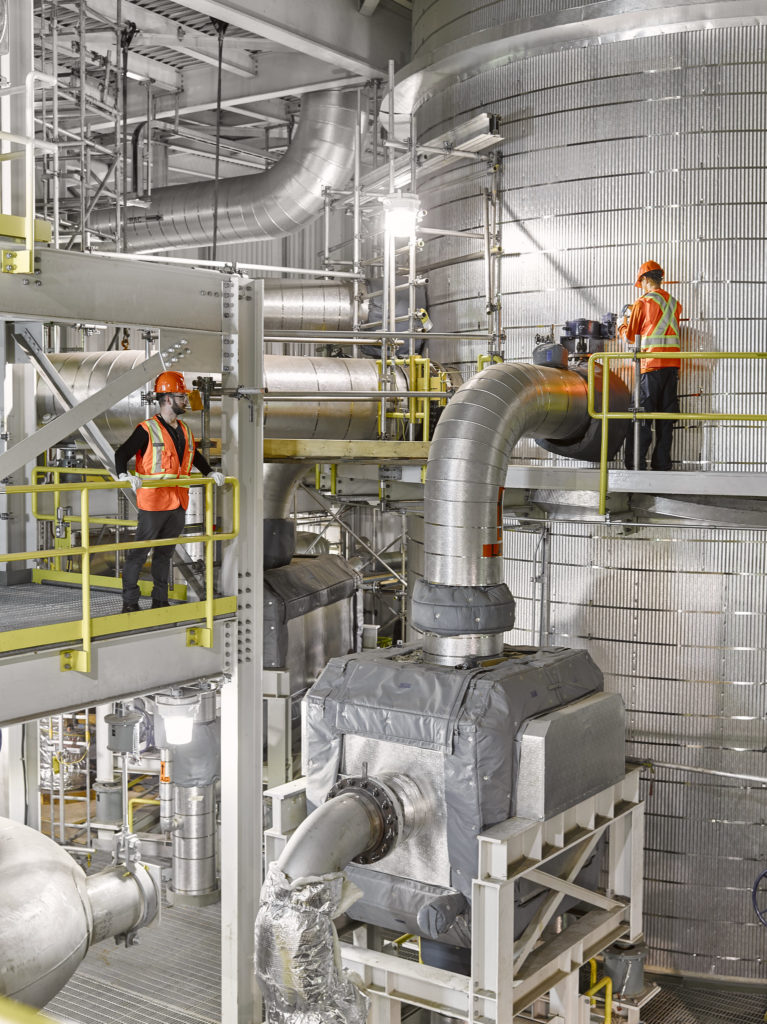
We recently explored the veritable rainbow of hydrogens, with different colors referring to the production method or original energy source used. One of the most heavily promoted options is ‘blue’ hydrogen. One must ask, if governments and energy companies….fossil fuel companies, to be specific…are promoting this as our ticket to limitless and sustainable energy, is there a catch? Well in fact, the downfall is the lack of ‘catch’. Blue hydrogen is named such due to the capture and storage of the CO2 which is a by-product of the steam methane reformation (SMR) process used in grey hydrogen production, where the origin energy source is methane – sometimes called natural gas or fossil gas. But carbon capture and storage (CCS) has many a question mark about its efficacy and ability to be scaled. A recent report from Global Witness underscores those questions, and more, in indelible ink.
Shell’s Scotford petrochemicals and tar sands oil complex in Alberta, Canada, has a CCS facility attached, called Quest. It is this add-on, which opened in 2015, which is at the center of this rather scathing report. Shell have been strongly advocating Blue hydrogen, basically claiming that CCS is the answer to all our problems and that Quest proves CCS is a “safe and effective measure to reduce CO2 emissions”. They also cleverly use the term ‘clean hydrogen’ when referring to either blue or green hydrogen production, despite there being very little ‘clean’ about blue hydrogen. And then, oddly, they’re quick to point out that green hydrogen is expensive and we’re many years away from having adequate renewable sources to produce it at large scale. With some convincing to do then, the marketing team worked overtime to produce the company’s ‘Powering Progress’ campaign, and have outdone themselves with diversity; inclusion; gleeful, laughing faces; and invoking innocence with the use of wooden block style images, leading you to recall happy childhood memories.
So thankfully, Global Witness investigated beyond the pretty images and wonderful sounding claims.
One such claim is that Quest, in only 5 years, has safely captured and stored 5 million tonnes of carbon dioxide! That’s a big number in anyone’s book. But – it’s not the full story. This is less than half of the emissions from the plant in the same length of time. Industry lobbyists purport that fossil hydrogen plants can capture over 90% of the emissions from their operation. In fact, Shell state that their CCS facilities, which use CANSOLV® technology (cue marketing team high fives) prevent over 99% of the CO2 emissions from their low pressure, post combustion flue gas. But Quest produced 7.5 million tonnes of CO2 – in addition to the 5 million which were captured. This equates to only 48% of emissions being stopped from hitting our atmosphere.

But even that isn’t the full story, because that figure doesn’t include the project’s overall emissions, which include those from methane pollution from extracting and transporting the methane – once those are calculated the efficacy of Quest’s emissions prevention drops to a paltry 39%. In real terms, that’s 4.81 of 7.66 million tonnes of greenhouse gases. While not making these figures public, it seems that Shell is aware that there is a gap between their claims and reality. So they are investing heavily (and seeking external investment) to improve their CCS facility. They’ve stated they ‘may’ try to increase the capture at Quest to 90% of emissions. But again – this leaves out some important facts. The most frightening is that the hydrogen produced will carry on being used to refine fossil fuels. And while investment is clearly still required, it should be noted that the cost of Quest sits at US$1 Billion – with an eye watering US$654 Million of that from government subsidies.

Another recent study has also disputed the cleanliness of blue hydrogen, finding that it had only 9 – 12% lower emissions than gray hydrogen production. And while that’s still lower overall GHG emissions, fugitive methane emissions alone are higher for blue hydrogen. This paper also questions the basis for CCS, being that it can store carbon indefinitely, which is unproven, and even suggests that the emissions from blue hydrogen are 20% larger than when burning natural gas or coal for heat, and 60% larger than using diesel oil specifically for heat. One of the most startling assertions from this paper is that the Hydrogen Council was formed in 2017…by BP and Shell among others. Looking at their website, those ‘others’ include SoCal Gas, Hyundai, Engie, Honda, EDF, BMW, Equinor, TotalEnergies, General Motors…the list goes on, and it’s a curious list, indeed.
So when your local or federal government start promoting Blue Hydrogen and CCS technology as our way out of the climate crisis, be sure to take it with a grain (or tablespoonful) of salt. And next time you see the fossil fuel industry making promises of leading us into a sustainable and happy future, be prepared to ask some questions and do some digging. We know that tech will help us navigate the next challenging decade, but it’s naïve to think tech can do all the work while we carry on as normal and not make any changes to lifestyle or behavior (or voting habits).



